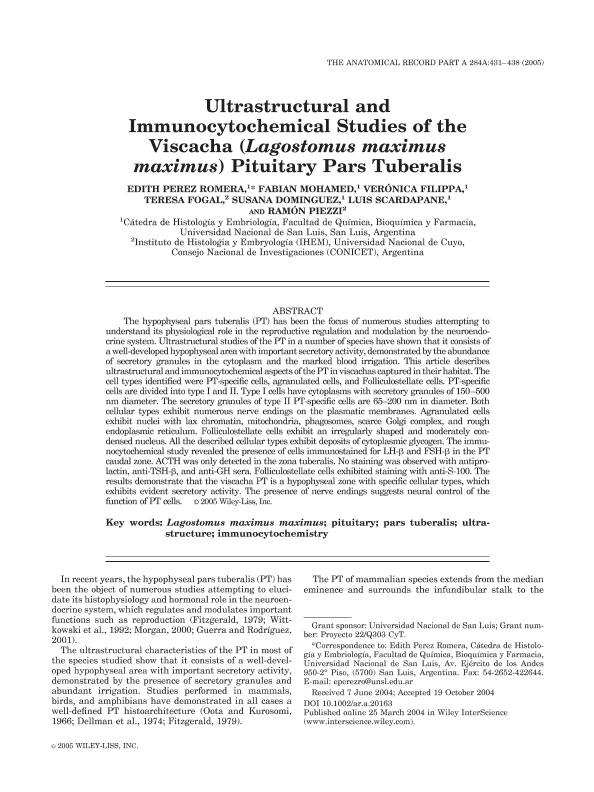Mostrar el registro sencillo del ítem
dc.contributor.author
Perez Romera, Edith
dc.contributor.author
Mohamed, Fabian Heber

dc.contributor.author
Filippa, Veronica Palmira

dc.contributor.author
Fogal, Teresa Hilda

dc.contributor.author
Dominguez, Susana
dc.contributor.author
Scardapane, Luis Antonio

dc.contributor.author
Piezzi, Ramon Salvador

dc.date.available
2022-06-16T02:27:38Z
dc.date.issued
2005-05
dc.identifier.citation
Perez Romera, Edith; Mohamed, Fabian Heber; Filippa, Veronica Palmira; Fogal, Teresa Hilda; Dominguez, Susana; et al.; Ultrastructural and immunocytochemical studies of the Viscacha (Lagostomus maximus maximus) pituitary pars tuberalis; Wiley-liss, div John Wiley & Sons Inc.; Anatomical Record; 284; 1; 5-2005; 431-438
dc.identifier.issn
1552-4884
dc.identifier.uri
http://hdl.handle.net/11336/159868
dc.description.abstract
The hypophyseal pars tuberalis (PT) has been the focus of numerous studies attempting to understand its physiological role in the reproductive regulation and modulation by the neuroendocrine system. Ultrastructural studies of the PT in a number of species have shown that it consists of a well-developed hypophyseal area with important secretory activity, demonstrated by the abundance of secretory granules in the cytoplasm and the marked blood irrigation. This article describes ultrastructural and immunocytochemical aspects of the PT in viscachas captured in their habitat. The cell types identified were PT-specific cells, agranulated cells, and Folliculostellate cells. PT-specific cells are divided into type I and II. Type I cells have cytoplasms with secretory granules of 150?500 nm diameter. The secretory granules of type II PT-specific cells are 65?200 nm in diameter. Both cellular types exhibit numerous nerve endings on the plasmatic membranes. Agranulated cells exhibit nuclei with lax chromatin, mitochondria, phagosomes, scarce Golgi complex, and rough endoplasmic reticulum. Folliculostellate cells exhibit an irregularly shaped and moderately condensed nucleus. All the described cellular types exhibit deposits of cytoplasmic glycogen. The immunocytochemical study revealed the presence of cells immunostained for LH- and FSH- in the PT caudal zone. ACTH was only detected in the zona tuberalis. No staining was observed with antiprolactin, anti-TSH-, and anti-GH sera. Folliculostellate cells exhibited staining with anti-S-100. The results demonstrate that the viscacha PT is a hypophyseal zone with specific cellular types, which exhibits evident secretory activity. The presence of nerve endings suggests neural control of the function of PT cells.
dc.format
application/pdf
dc.language.iso
eng
dc.publisher
Wiley-liss, div John Wiley & Sons Inc.

dc.rights
info:eu-repo/semantics/openAccess
dc.rights.uri
https://creativecommons.org/licenses/by-nc-sa/2.5/ar/
dc.subject
IMMUNOCYTOCHEMISTRY
dc.subject
LAGOSTOMUS MAXIMUS MAXIMUS
dc.subject
PARS TUBERALIS
dc.subject
PITUITARY
dc.subject
ULTRASTRUCTURE
dc.subject.classification
Bioquímica y Biología Molecular

dc.subject.classification
Ciencias Biológicas

dc.subject.classification
CIENCIAS NATURALES Y EXACTAS

dc.title
Ultrastructural and immunocytochemical studies of the Viscacha (Lagostomus maximus maximus) pituitary pars tuberalis
dc.type
info:eu-repo/semantics/article
dc.type
info:ar-repo/semantics/artículo
dc.type
info:eu-repo/semantics/publishedVersion
dc.date.updated
2022-06-13T18:49:59Z
dc.journal.volume
284
dc.journal.number
1
dc.journal.pagination
431-438
dc.journal.pais
Estados Unidos

dc.journal.ciudad
Washington
dc.description.fil
Fil: Perez Romera, Edith. Universidad Nacional de San Luis; Argentina
dc.description.fil
Fil: Mohamed, Fabian Heber. Universidad Nacional de San Luis; Argentina
dc.description.fil
Fil: Filippa, Veronica Palmira. Universidad Nacional de San Luis; Argentina. Consejo Nacional de Investigaciones Científicas y Técnicas. Centro Científico Tecnológico Conicet - Mendoza; Argentina
dc.description.fil
Fil: Fogal, Teresa Hilda. Consejo Nacional de Investigaciones Cientificas y Tecnicas. Centro Cientifico Tecnologico Conicet - Mendoza. Instituto de Histologia y Embriologia de Mendoza Dr. Mario H. Burgos. Grupo Vinculado de Investigacion y Desarrollo Biotecnologico Aplicado Al Diagnostico Al Ihem | Universidad Nacional de Cuyo. Facultad de Ciencias Medicas. Instituto de Histologia y Embriologia de Mendoza Dr. Mario H. Burgos. Grupo Vinculado de Investigacion y Desarrollo Biotecnologico Aplicado Al Diagnostico Al Ihem.; Argentina
dc.description.fil
Fil: Dominguez, Susana. Universidad Nacional de San Luis; Argentina
dc.description.fil
Fil: Scardapane, Luis Antonio. Universidad Nacional de San Luis; Argentina
dc.description.fil
Fil: Piezzi, Ramon Salvador. Consejo Nacional de Investigaciones Cientificas y Tecnicas. Centro Cientifico Tecnologico Conicet - Mendoza. Instituto de Histologia y Embriologia de Mendoza Dr. Mario H. Burgos. Grupo Vinculado de Investigacion y Desarrollo Biotecnologico Aplicado Al Diagnostico Al Ihem | Universidad Nacional de Cuyo. Facultad de Ciencias Medicas. Instituto de Histologia y Embriologia de Mendoza Dr. Mario H. Burgos. Grupo Vinculado de Investigacion y Desarrollo Biotecnologico Aplicado Al Diagnostico Al Ihem.; Argentina
dc.journal.title
Anatomical Record

dc.relation.alternativeid
info:eu-repo/semantics/altIdentifier/doi/http://dx.doi.org/10.1002/ar.a.20163
dc.relation.alternativeid
info:eu-repo/semantics/altIdentifier/url/https://anatomypubs.onlinelibrary.wiley.com/doi/10.1002/ar.a.20163
Archivos asociados
